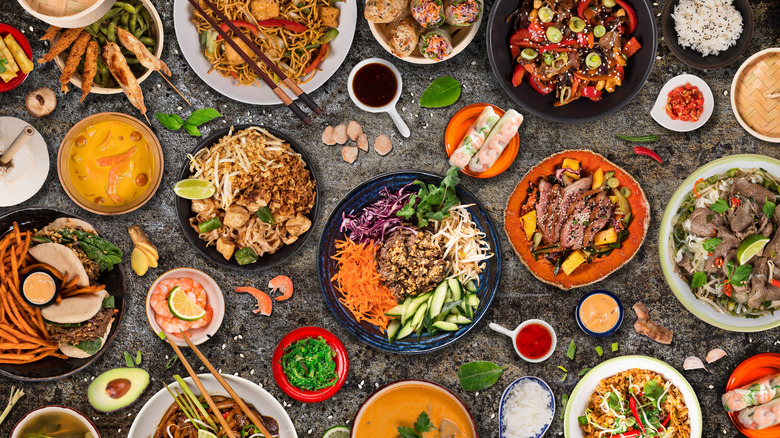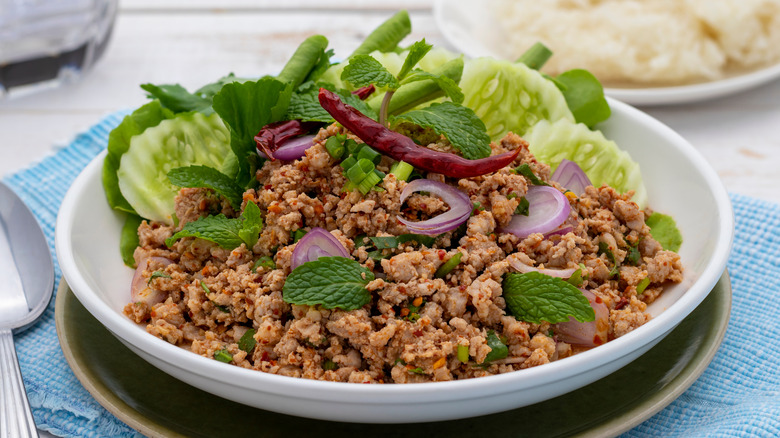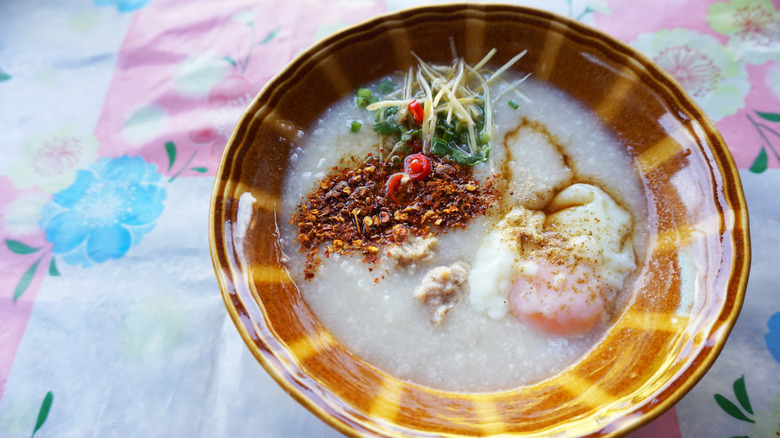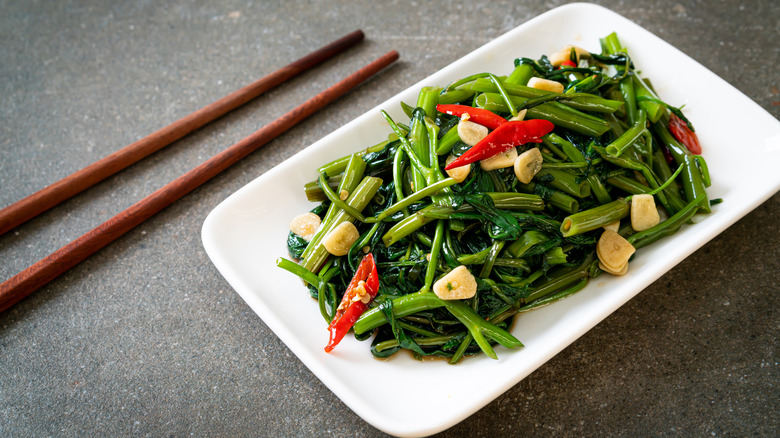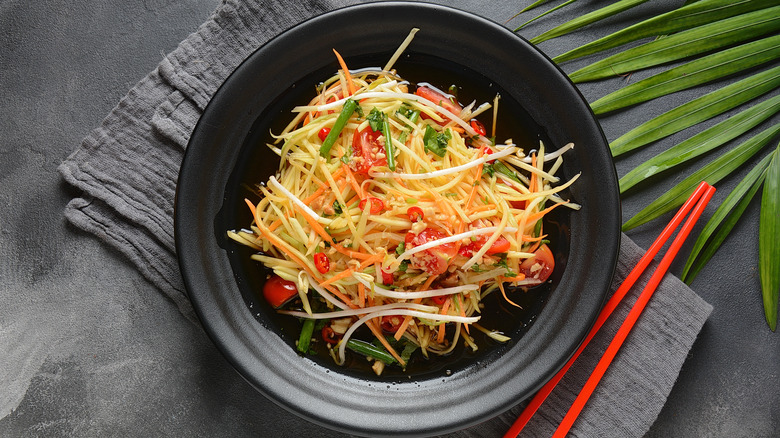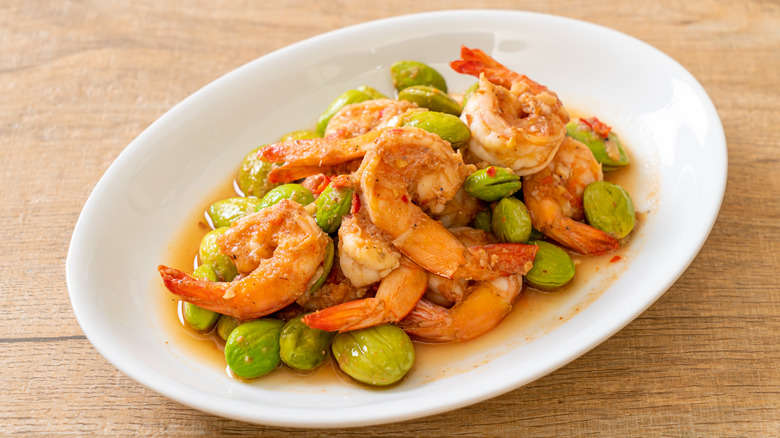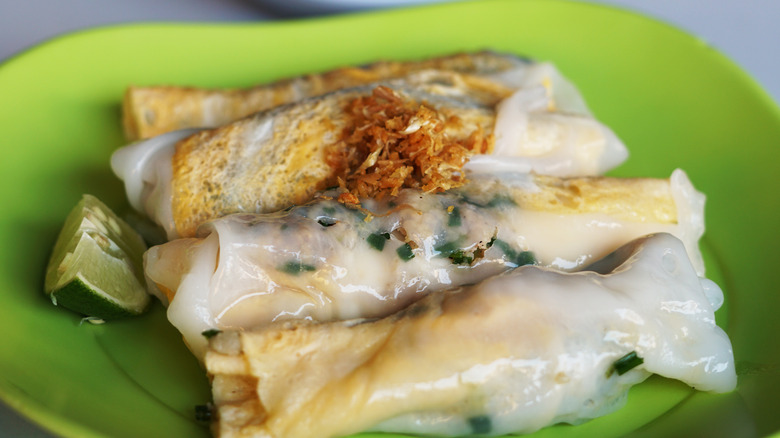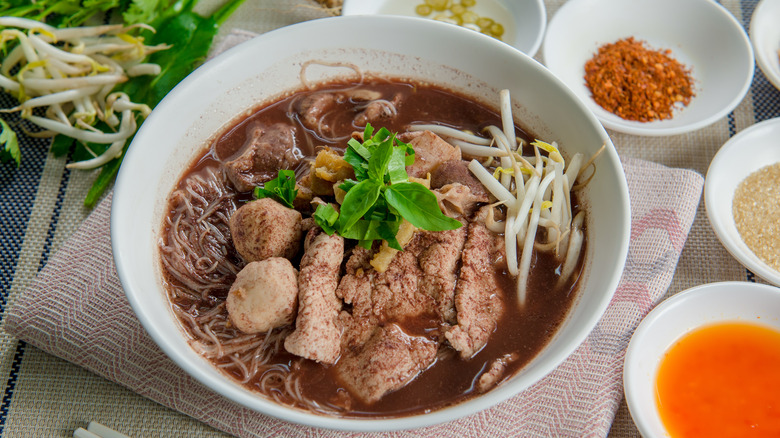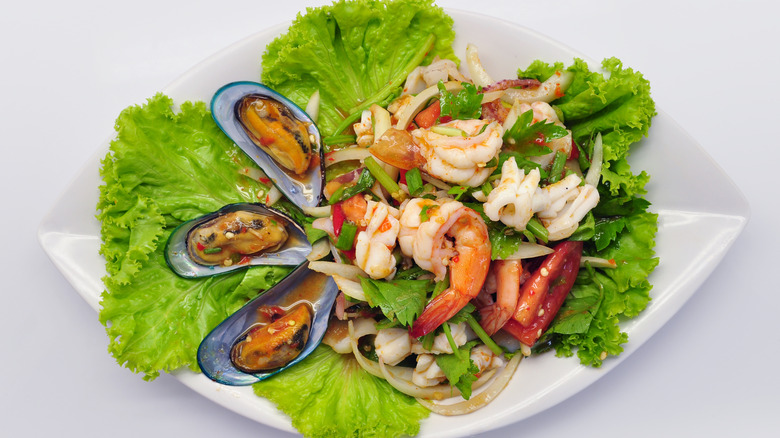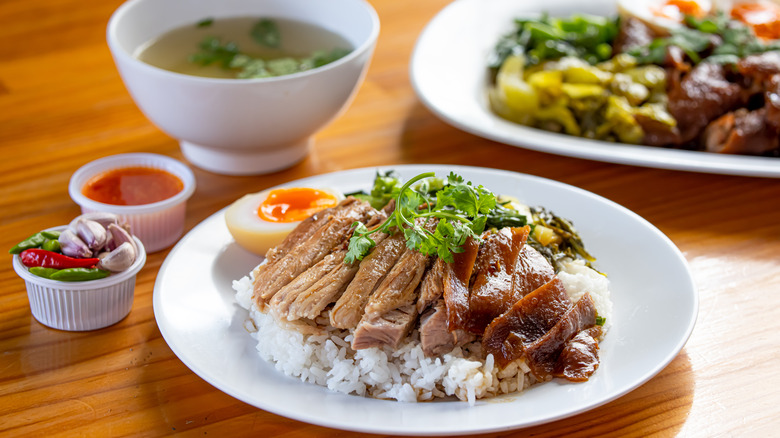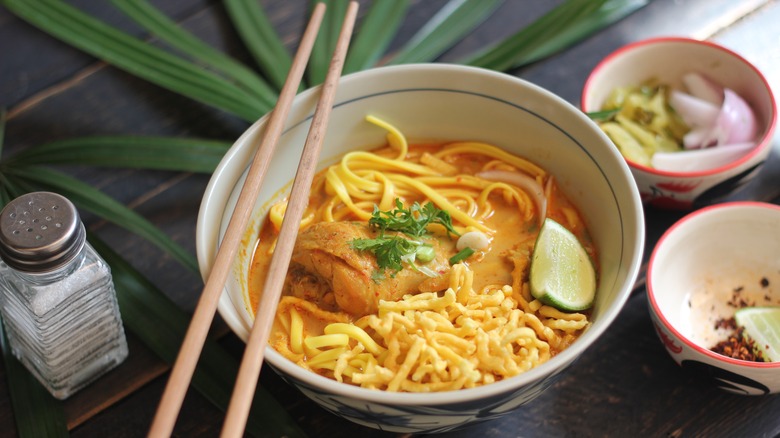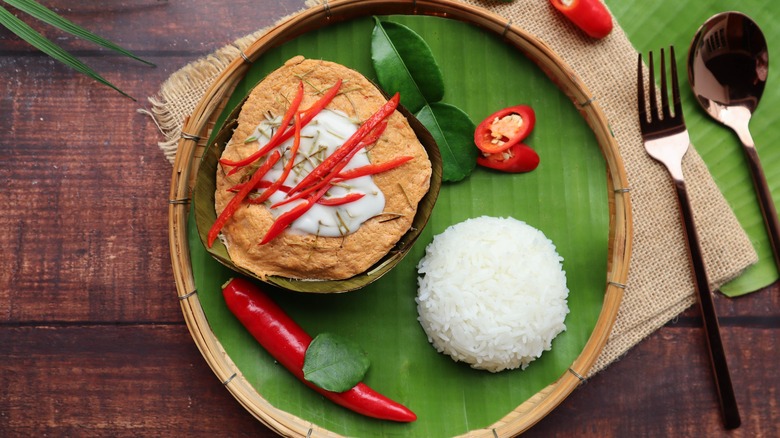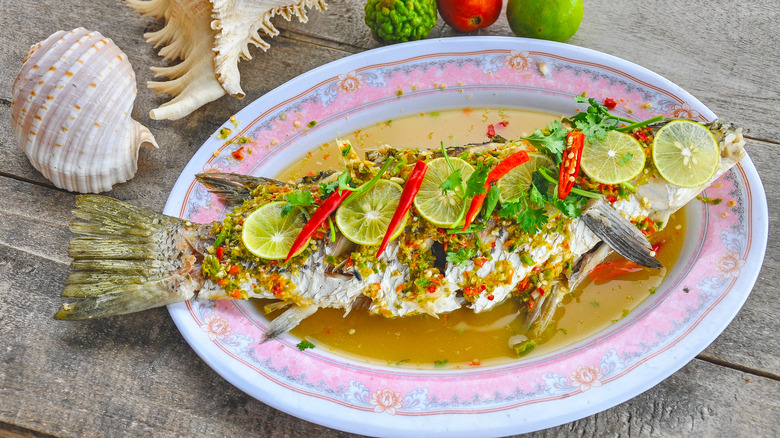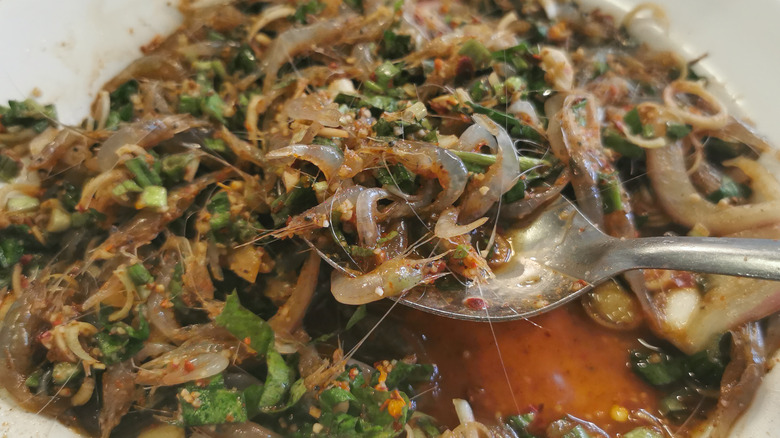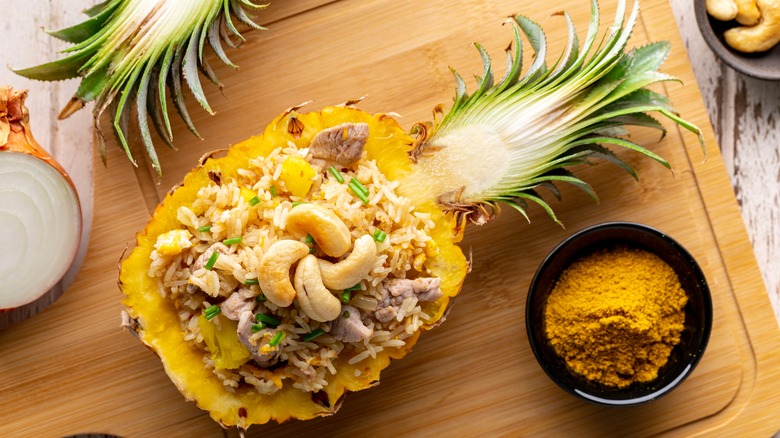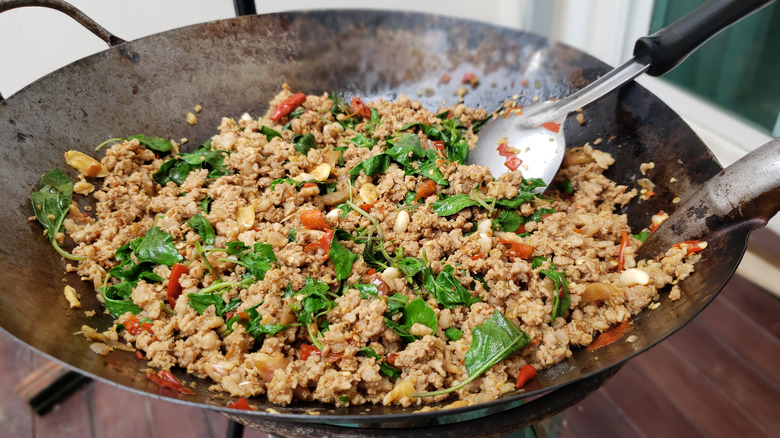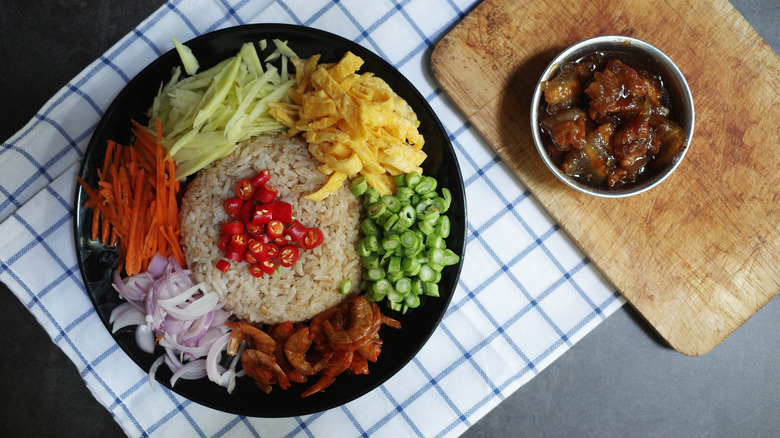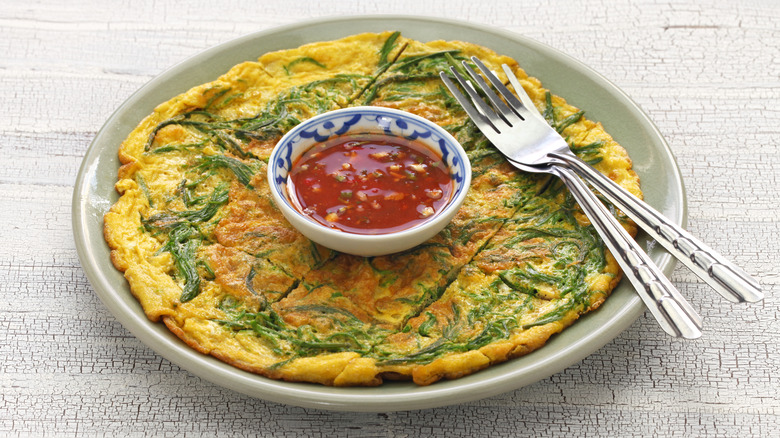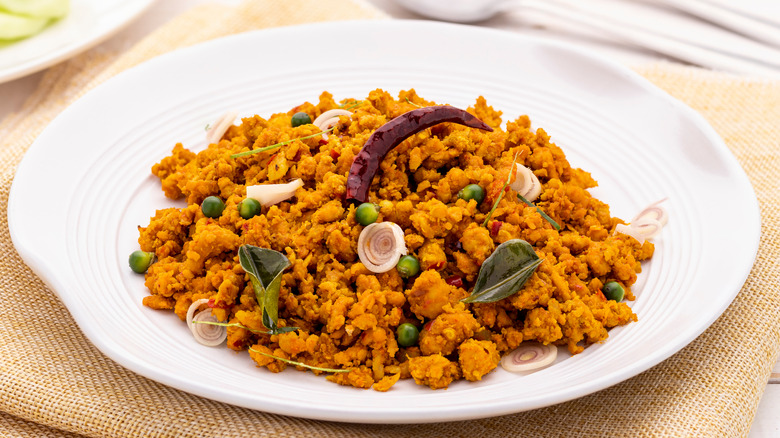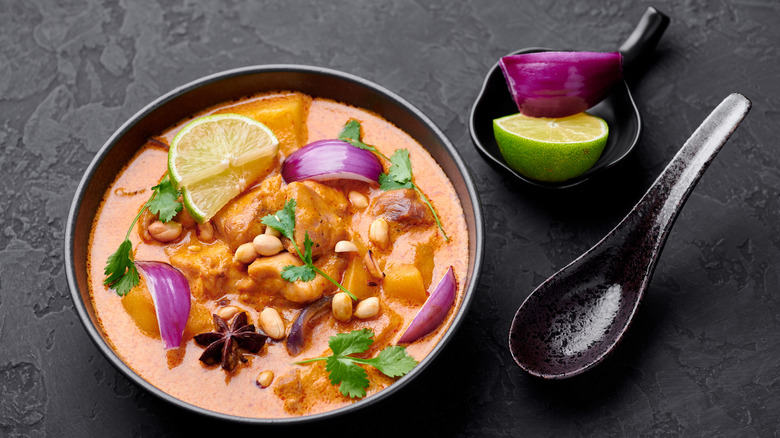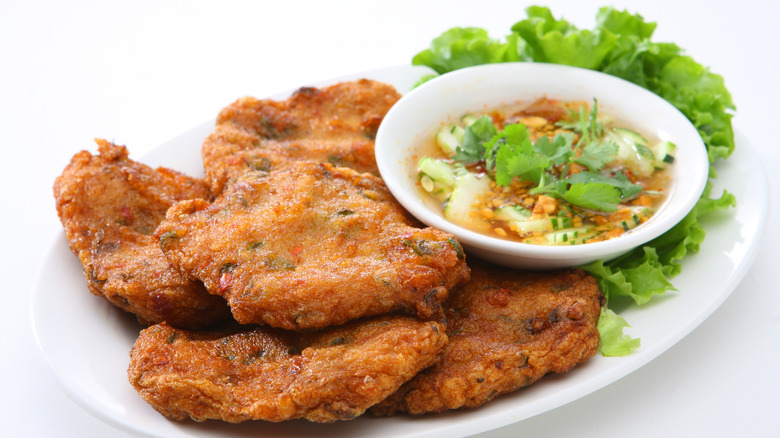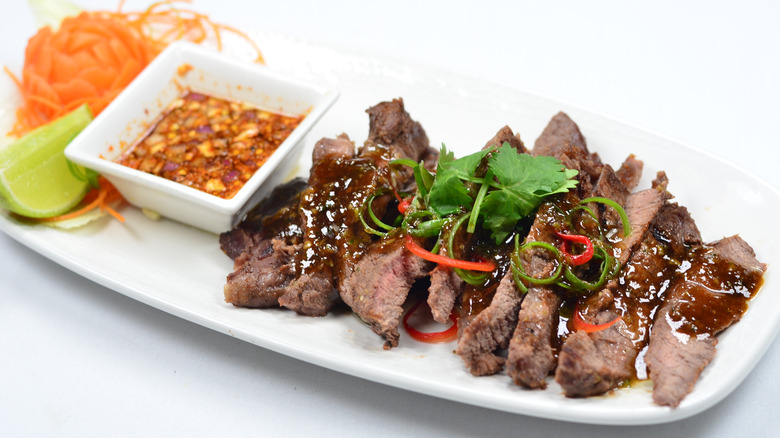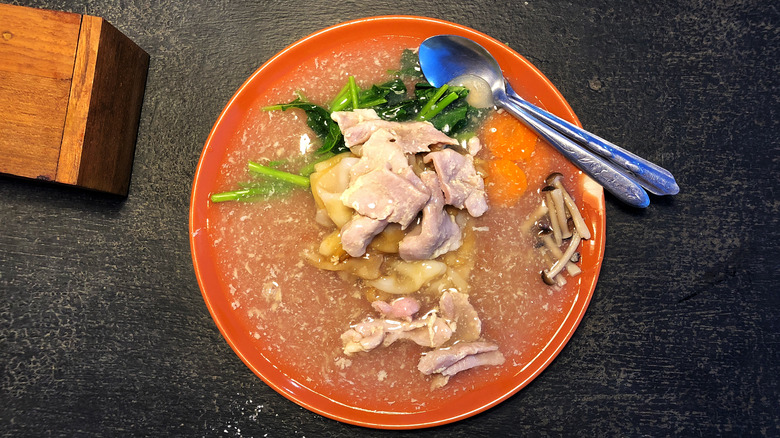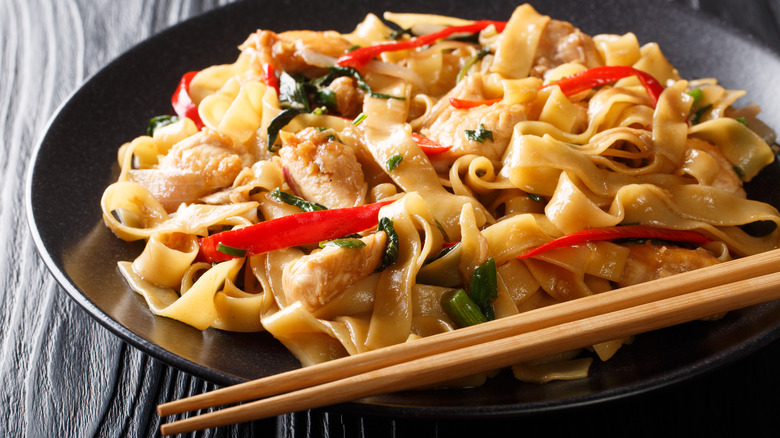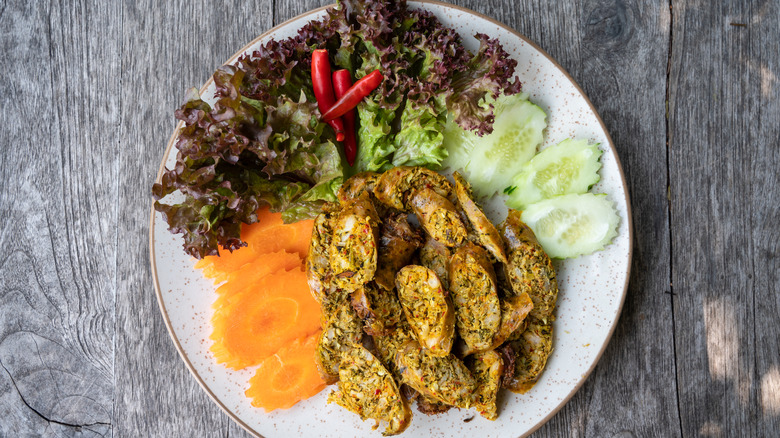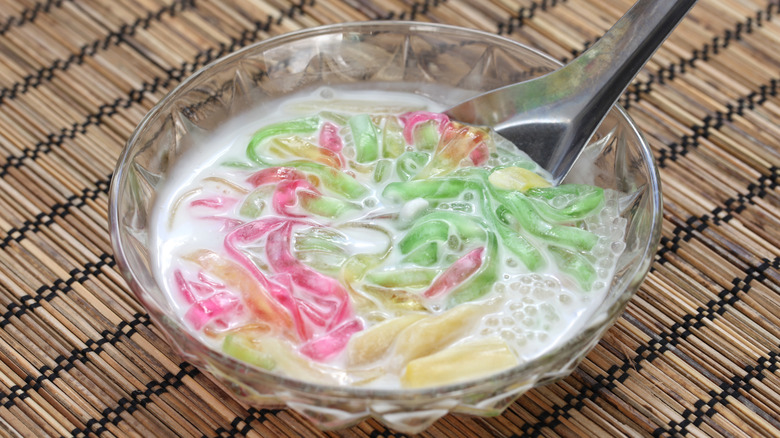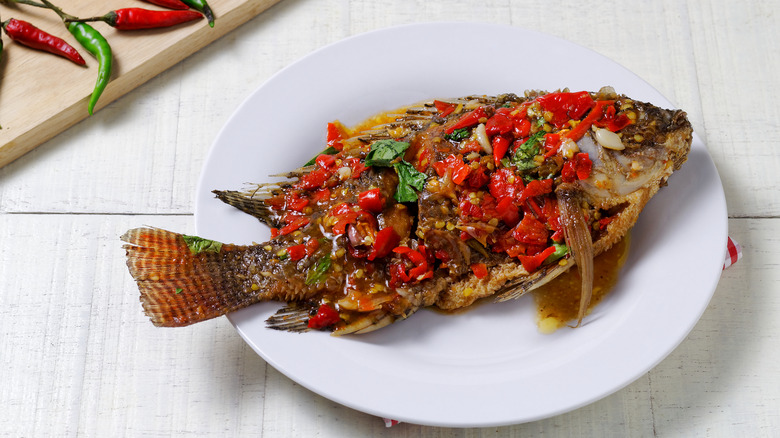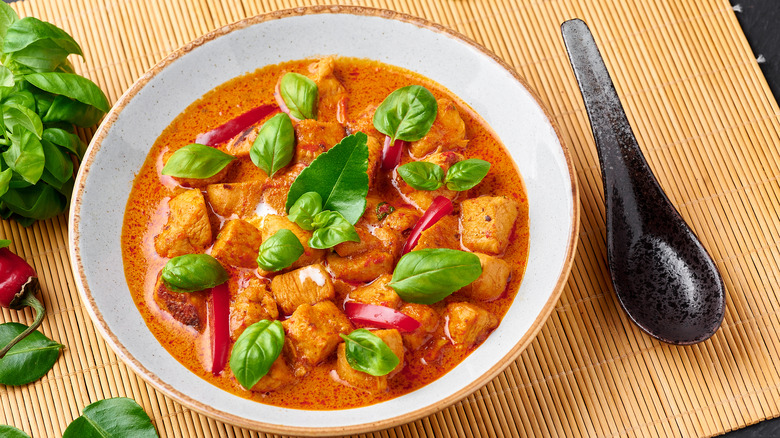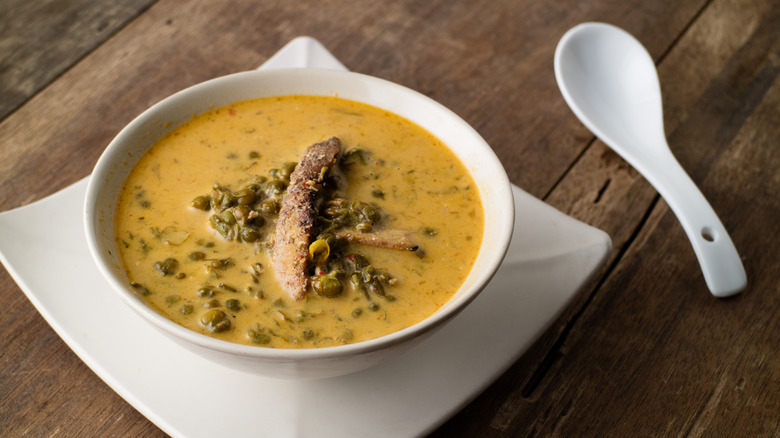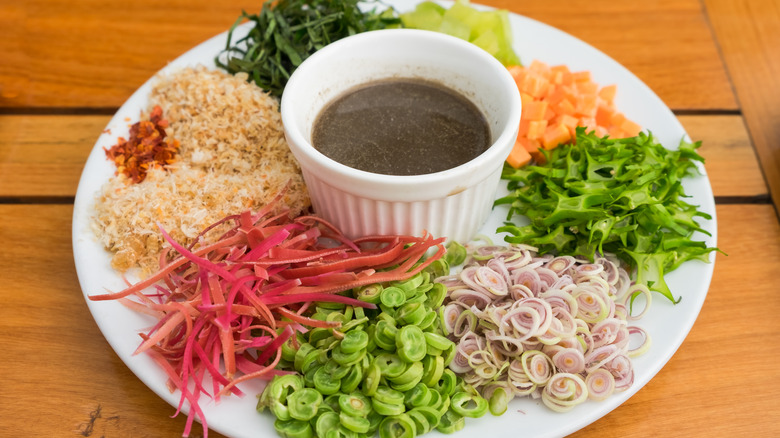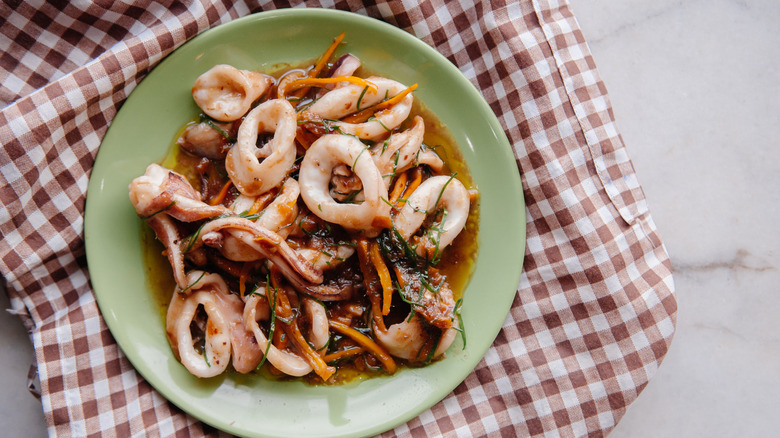The Best Thai Food You Probably Haven't Tried Yet
From a range of exciting ingredients to tantalizing flavors that light up your palate, Thai food has it all. The harmonious combination of sweet, sour, salty, and spicy tastes makes every dish a journey for the senses. While some specialties are undoubtedly not for the faint-hearted, Thai food can be as comforting as it is thrilling.
If you've gotten used to sticking with a few favorite items on Thai restaurant menus, it's time you ventured away from the ordinary and tried something new. Thanks to its location bordering Cambodia, Laos, Myanmar, Malaysia, and the Gulf of Thailand, the country has an abundance of culinary influences that are well reflected in its cuisine. From hot spicy curries and rich soups to raw zesty salads and seafood delights, there is no lack of variety in The Land of Smiles.
We've collected our top list of dishes that are sure to make you smile. And while you can keep ordering classics like pad Thai and tom yum soup, step outside the box and savor the diverse choices available at your local Thai restaurant — or better yet — on a trip to Thailand.
Larb
Although the various spellings — laab, larb, laap, larp — can mislead you into thinking each is a novel dish, in fact, they are one and the same. Larb is a spicy salad with a few different iterations, all containing minced meat (beef, buffalo, pork, duck, chicken) or fish. Although Culinary Lore points out that it is typically considered to be the national dish of Laos, it's just as much of a staple in the bordering regions of northeastern Thailand. Though Thai food and Laotian food are different, the two cuisines share many dishes, as we'll see.
Along with the finely chopped meat (which is where the name comes from, per 196 Flavors), mint, basil, cilantro, lime juice, fish sauce, chilis, shallots, and toasted rice season the dish, as Story Maps explains. In an interview with the author's Thai grandmother, she notes that there are countless takes on the dish, ranging from mild to spicy depending on the proportions. In fact, some renditions are stir-fried (larb suk), others are made with raw meat (larb dip), and yet another variety features an entirely different spice profile including cumin, star anise, cinnamon, and cloves.
While the dish is sometimes consumed in a lettuce wrap, 196 Flavors reports that in Thailand, it is more common to eat it with sticky rice or raw vegetables. Enjoy it as an appetizer or as one of many small plates to share with the table.
Jok
A bowl of porridge might not be what you imagine when you think of Thai food. Nonetheless, a rice-based version is a comforting breakfast and snack food for any time of the day that many locals regularly enjoy. Thaiger compares the warm meal to Chinese congee or basic instant oatmeal, yet it has its own Thai flair.
According to the Bangkok Post, Jok is made with bits of rice that break during the milling process, producing a tender result. Given that less than perfect grains aren't as desirable in other rice-based dishes, jok is a great way to use them up. In some cases, the soft consistency is amplified by grinding the rice further until it is almost flour-like.
The dish doesn't end with just the rice. Jok is often served with seasoned pork, egg, spring onions, ginger, fried bread, and crispy noodles, Bangkok Post notes. A splash of soy sauce and a crack of black pepper provide extra flavor, and mushrooms add the perfect touch of umami.
Pak boong
A plate of greens is the perfect contrast to steaming bowls of rice, rich curries, and noodle dishes. That's not to say that pak boong isn't packed with flavor though. Stir-fried morning glory leaves (or water spinach) are seasoned with garlic, chili, oyster and fish sauce, fermented black beans, and a pinch of sugar, per Indochina Value. According to Thai Food Paradise, a quick two-minute stir fry is all that stands between you and a plate of pak boong.
The classic recipe contrasts bright flavors with fresh morning glory shoots. The Bangkok Post notes that there are a few varieties of the plant, some that grow in swamps and others in fields or gardens. Enjoy pak boong solo in between bites of mixed dishes or serve it simply with white rice. Either way, you'll get your vitamin fix and a host of other health benefits including improved blood sugar and memory as well as reduced fatigue, per the Bangkok Post.
Som tum
A crunchy tangy papaya salad is one of the more refreshing dishes in Thai cuisine, though it likely has Laotian origins, according to Thai Ginger. Perfect as a bold appetizer to awaken your palate, som tum is an easy favorite. Apart from shredded papaya (the green variety), Culture Trip lists ingredients such as chilis, garlic, tomatoes, green beans, carrots, roasted peanuts, palm sugar, fish sauce, and dried shrimp, all tossed in a sweet, sour, and salty lime sauce. The seasoning ingredients are pounded to produce a paste-like consistency that coats the papaya and vegetables with flavor.
While the classic is unforgettable, it's worth trying one of many variations developed from this dish, and you can bet that with such a delicious foundation, every unique twist amplifies this zesty salad. Per Yin Teing's Thai travel blog, papaya salads with shellfish, crab, chicken, mango, or corn are all common variations. Culture Trip remarks that regional styles are prevalent, and individual differences mean you will never have the same dish twice.
Plus, diners often have a say in the balance of flavors in the salad — be sure to adjust if you can't handle a chili overload. Som tum's crispy texture makes an excellent contrast to sticky white rice, especially if the heat is a bit overwhelming.
Goong pad sataw
Some foods are distinctly unappealing from the first whiff, yet reward those who decide to venture for a taste. Goong pad sataw or shrimp with stink beans is a great example. While the shrimp are tame and familiar, the beans are distinctly pungent, sometimes described as methane-like. The younger and fresher the beans, the milder the scent, and a pleasant nutty flavor and crisp bite add some allure. In fact, they are quite popular among diners, and The Phuket News reports that they have many health benefits.
The outlet notes that the beans are typically cooked with equally flavorful ingredients — curry and shrimp paste, turmeric, garlic, chilis, lemongrass, and makrut lime leaves are common. Fry the beans up with the pastes and large shrimp (a pork version is also served) and accompany it with a steaming plate of rice for an authentic southern Thai dish that will have you longing for more stink beans in your life, per Eating Thai Food.
Khao kriab pak moh
Thai food consistently displays a playful balance of flavors, and khao kriab pak moh is no different, showcasing the ideal combination of sweet, salty, and spicy tastes (per Eating Thai Food). The Bangkok Post reports that as with many Thai delicacies, it is in fact of Vietnamese origin. Nevertheless, it's now a common street snack in Thailand and it's the perfect type of recipe to experiment with on a rainy day.
While it's undoubtedly its own dish, khao kriab pak moh can be likened to a thin pancake or crepe made with tapioca starch and rice flour. The filling is decidedly Thai, with pork, coriander, garlic, pepper, peanuts, radish, palm sugar, soy sauce, and various spices (via Eating Thai Food). Other proteins such as chicken or shrimp are also used, as well as mixed vegetables. The wrapper is gently steamed, loaded up with the pork mixture, and folded into a convenient dumpling format. Expect extra chilis, fresh cilantro, and crispy lettuce leaves garnishing the soft pockets.
Guay teow ruea
Countless Thai dishes showcase noodles front and center, and guay teow ruea is a beloved favorite. The meal is more simply referred to as boat noodles, named for its typical point of sale — and production — along the canals of Bangkok (via Food Republic). According to the Bangkok Post, the particular area of Thailand where this dish developed had a large Chinese population at the end of the 19th century. As noodles appear to have originated in China per The Atlantic, it's not surprising that the inhabitants soon began making and selling a noodle dish.
The noodles are rice-based, resulting in a pleasantly chewy consistency, SBS explains, complemented by bean curd, meat, and fresh coriander. As for the broth, expect rich heady aromas with ingredients like galangal, ginger, lime leaves, lemongrass, pepper, cinnamon, and other spices. Traditionally, the combination was served in small portions since vendors didn't have much capacity to hold hot water and large bowls on their boats (via the Bangkok Post).
Vegetarians should steer clear of this dish, as Thai food expert David Thompson tells SBS that classic renditions are served with pig or cow blood. Part flavoring agent, part thickener, the blood is a key element in the soupy noodle dish. Nonetheless, due to issues accessing the liquid at its freshest, many modern recipes omit it. Crosscut describes a restaurant near Seattle that uses coconut milk instead.
Yum talay
Thai seafood dishes are among the best, and the variety means that there's always something new to taste. Take yum talay, a spicy seafood salad that's perfect when you're hungry for a fresh vibrant meal packed with wonders from the sea. Thai Food Online notes that the dish can be enjoyed as a flavorful appetizer or even as a main course. The outlet adds that a more filling version incorporates glass noodles.
Fine Cooking explains that seafood — mussels, shrimp, squid, scallops, crab, you name it — is mixed with the ubiquitous multiflavored combination of fish sauce, lime juice, garlic, chilis, and fresh herbs. In regions further inland, the recipe is heavier on fish and lighter on shellfish which doesn't remain fresh as long (via Thai Food Online). If you're making it yourself, be sure only to dress the salad shortly prior to consuming it to maintain the zesty flavors. Typically, the dish is served with leafy greens, staying true to its salad label.
Khao ka moo
The dishes that appear the simplest can easily be the most comforting and that's certainly the case with khao ka moo, or braised pork leg with rice. The meat's cooking method guarantees a deliciously tender texture, rich with flavor. This classic Thai recipe does not disappoint, and while the Bangkok Post notes that it has Chinese origins, it is now ubiquitous in Thailand. Thanks to the decadently fatty profile of the pork, the outlet describes it as "a dish that's sure to lead you to temptation."
In addition to the rich nature of the meat, layers of flavor are added by first grilling the pork leg and then stewing it in a combination of seasonings including soy sauce, palm sugar, oil, peppercorns, garlic, Chinese five-spice, and coriander root. Chef customizations are the norm yet the balance of sweet and salty unites all renditions. Typically, the lower and upper parts of the leg are prepared separately and then combined in the stew (via the Bangkok Post).
There's so much flavor in the pork alone that it's no wonder the meat is served simply with steamed rice, and perhaps pickled cabbage and Chinese broccoli. Finally, extra garlic and fresh coriander add some brightness that will keep you coming back for more.
Khao soi
Khao soi or yellow curry noodles is a delicious meal you'll want to start eating on the regular. According to SBS, yellow egg noodles are a defining feature of the dish. They're complemented by a rich red curry paste and coconut milk broth. Some chicken, beef, pork, or tofu hearten up the recipe, while a crispy noodle garnish, chili oil, pickled cabbage, shallots, cilantro, and lime juice bring it to life, Foodicles explains. Although the dish is served in great numbers in Chiang Mai in northern Thailand, it actually has Muslim Chinese origins.
Curry paste is heavily used in Thai cuisine, and the red variety is a feast for the senses. SBS lists chili, turmeric, cumin, coriander, ginger, shallot, turmeric, and cardamom among the many spices present in the fragrant blend. Coconut milk, fish sauce, palm sugar, and soy sauce work together harmoniously to highlight the dish's overall sweet, salty, sour, and spicy flavors. Per The Wall Street Journal, the use of coconut milk in this area of Thailand suggests an influence from neighboring Myanmar, where a similar recipe is served.
Ho mok maphrao on
Ho mok maphrao on is a seafood coconut curry dish with a unique presentation that is particularly appealing. Typically, the curry is steamed in a young coconut shell, although FoodOf notes that some versions are steamed in banana leaves instead. A similar dish known as fish amok is hugely popular in Cambodia, though the Thai rendition tends to be spicier according to The Wall Street Journal, thanks to extra chili peppers garnishing the top for a fiery kick.
Per Taste Atlas, the dish is commonly made with red curry paste, coconut cream, and aromatic seasonings like galangal, makrut lime leaves, basil, fish sauce, and sugar. Base ingredients like onion, garlic, ginger, and lemongrass provide plenty of spark to simple white fish and assorted seafood like shrimp, squid, and mussels. All you need is a bowl of steamed white rice to mop up the rich stew and have a filling meal.
Pla kapong neung manao
With fantastic access to seafood from the Gulf of Thailand, it's no surprise that the country's cuisine showcases its freshness with simple seasoning. Pla kapong neung manao is a steamed fish dish with lime juice, garlic, lemongrass, cilantro, and chili, per 196 Flavors. What the dish lacks in ingredients it makes up for with a delightfully zesty flavor. The steamed preparation over an open flame works well with barramundi (also known as Asian sea bass), the classic fish used in this recipe.
196 Flavors notes that the same recipe can be made with snapper, tilapia, or grouper; however, if you're eating it at the source you'll most likely be served barramundi. Don't expect perfect filets — instead, a whole fish is presented, head and all. According to Eating Thai Food, the dish is served on a fish-shaped plate, further highlighting the contents. The brothy juice from the fish and seasoning is ideally sopped up with steamed jasmine rice.
Goong ten
Goong ten might not appear to be the most palatable dish on our list, but this Thai specialty is a must-try for the less squeamish. According to Atlas Obscura, this northeastern street food is also known as dancing shrimp, because, well they're still alive. This raw preparation consists of a plate of shrimp seasoned in a tangy marinade of chili, fish sauce, and lime. Fresh mint, lemongrass, and shallots are sprinkled over top to garnish the wriggly shellfish.
Per Atlas Obscura, if you aren't up for seeing your food squirm around as you take a bite, the shrimp can also be wrapped in betel leaves. Typically, goong ten is served with sticky rice to soak up the zingy flavors of the shrimp marinade. If you're curious to give it a try, the recipe is pretty straightforward to make once you get your hands on extra fresh live shrimp. Although you likely won't find it in most restaurants, this authentic northern Thai street food is worth seeking out for adventurous travelers.
Khao pad sapparod
If aesthetics are just as important to you as flavor, you'll want to order khao pad sapparod for your next Thai meal. Pineapple fried rice is certainly a showstopper on the table, and with little effort, the results are quite impressive. According to Asian Food Network, the dish was probably created by the Thai Chinese population, and since, it has become a mainstay among locals and Westerners alike.
SBS explains that the key to the recipe is using dry room temperature jasmine rice and an extra hot wok to fry it up, ensuring delicious toasted flavors. The fried rice is typically seasoned with garlic, shallots, soy, fish, and oyster sauces, and sugar, while spring onions, cashews, and fresh cilantro add a crunchy garnish. Shrimp is the usual protein add-in but chicken or pork can also be used. Once the rice has been fried up, it is loaded into a hollowed pineapple half, amplifying the quintessential Thai combination of sweet, sour, salty, and spicy tastes.
Pad krapao moo
A few basic ingredients can really shine when they're packed with flavor, and pad krapao moo takes advantage of fragrant holy basil. The Guardian describes it as having aniseed aromas, and clove and cinnamon are often mentioned too. This savory blend combines harmoniously with classic ingredients like chili and garlic. Apart from the basil and seasonings, the bulk of the dish consists of minced pork that is fried together with the leaves. Soy sauce, oyster sauce, and sugar round out the classic pairing of salty and sweet flavors, making pad krapao moo a comforting favorite.
For a complete presentation, the author of The Guardian article recommends serving it with steamed jasmine rice with a fried egg on top. According to Taste of Thailand, this tasty fry-up is a common lunchtime treat and is sometimes served with ground chicken, beef, or squid instead of pork. One ingredient remains indispensable in all versions: the holy basil.
Khao kluk kapi
Fried rice lovers rejoice: Khao kluk kapi is a flavor bomb of a dish, thanks to the notable presence of shrimp paste. Saveur claims this meal alone is worth the trip to Bangkok, but if you can source the ingredients, then a fair approximation can be made from your own kitchen. Nonetheless, the recipe is fairly time-consuming as various steps must come together to create this multilayered dish (via Thailand Life).
Long-grained rice forms the base per Saveur, and a paste made from dried and fermented krill packs in the flavor. The outlet notes that some versions of khao kluk kapi consist only of seasoned rice, yet others are served with pork for a more complete dish. The pork gets a typical Thai preparation with garlic, palm sugar, soy sauce, and cilantro root until it is sticky and sweet. Finally, to counter the funky sweet combination of the rice and pork, fresh garnishes accompany the dish: shallots, chilis, green mango, lime juice, omelet strips, and dried shrimp.
Kai jeow
A well-made omelet is the stuff of dreams for many people, and the Thai version — kai jeow — will convert whoever doesn't yet agree. The crispy yet simultaneously fluffy egg dish has the familiar flavor of fish sauce, while a splash of soy sauce brings on the salt (via Saveur). A small amount of cornstarch or rice flour helps amplify the crispy sides, according to Serious Eats. Kai jeow is definitely an example of simplicity at its finest.
As Eating Thai Food explains, instead of slowly cooking the eggs in oil or butter, the Thai style opts for deep frying in oil. The eggs are vigorously beaten and then cooked quickly at high heat (the oil should be just about smoking), creating a crispy exterior and a light interior.
Whether it's served up plain with rice and sweet chili sauce or loaded up with scallions, shrimp, minced pork, or other fillings, the result is a perfectly satisfying dish made from kitchen staples. And while it will surely set you up for the day if you have it at breakfast, this delicious omelet shouldn't be restricted to morning meals.
Khua kling
Unlike familiar stew-like Thai curries, khua kling is a dry curry prepared with minced pork and a flavorful paste, Taste Atlas explains. The outlet lists chilis, galangal, lemongrass, garlic, turmeric, cilantro, sugar, fish sauce, and shrimp paste among the seasoning agents, and you can bet they add a punch. Whereas soupier curries include coconut milk or other liquids, khua kling is more akin to a stir fry, as the pork is fried up with the paste. If you're making it at home you'll have to keep stirring the meat to prevent it from sticking.
Eating Thai Food specifies that the dish is typical in southern Thailand, and variations using chicken or beef are also popular. According to Serious Eats, authentic khua kling recipes are guaranteed to be spicy, so take it easy if you aren't used to the heat. You can also tone it down by pairing the dry curry with steamed white rice and cooked vegetables for a complete meal.
Massaman curry
Known as one of Thailand's core curries, massaman curry is an essential part of the country's cuisine. In fact, in 2021 it topped CNN's list of the world's best dishes. Anyone eager to send their palates on a sensory journey should taste the flavorful dish.
According to Taste Atlas, the curry is slowly cooked over time, typically incorporating tougher pieces of meat from lamb, beef, or chicken which tenderize throughout the process. Potatoes and vegetables add some bulk, but the layered flavors and mild sweetness come from coconut milk and curry paste.
This is a bright red curry, and Taste Atlas lists cumin, cardamom, coriander, cloves, star anise, cinnamon, garlic, chili, galangal, lemongrass, tamarind, and sugar among the ingredients responsible for its rich aromatic flavors. Crushed peanuts are often sprinkled over top for textural contrast in every bite.
Taste Atlas indicates that the dish likely has origins in Malaysia and with Muslim traders from the Middle East and India, which explains some of the spice profile. You won't want to waste any of the sauce so be sure to enjoy a bowl of massaman curry with white rice.
Tod mun pla
With so much fish on offer in coastal Thailand, it's not surprising that tod mun pla (Thai fish cake) is a great way to make use of the abundance. Per Thai Table, the tasty treats are commonly sold by street vendors thanks to their convenient format. A bowl of rice makes the perfect accompaniment to round them out into a full meal but the fritters are easily enjoyed as an appetizer or afternoon snack.
Thai Food Heritage describes that a firm white fish is generally ground into a texture similar to a paste, which is then mixed together with a classic red curry paste (chili, lemongrass, galangal, shallots, garlic, cilantro, and more). An egg is used as a binder, and 196 Flavors notes that chopped long green beans are often incorporated too. Meanwhile, a chili cucumber peanut dipping sauce has both spicy and crunchy elements that complement the fried fish cakes.
Suea rong hai
With a name that translates to crying tiger, suea rong hai is sure to pique your curiosity. No tigers are harmed in the making of this dish; instead, the preparation consists of spicy beef brisket that is grilled and accompanied by sticky rice (via Taste Atlas). To add extra heat, the beef strips are paired with a chili sauce seasoned with the usual fish sauce, lime juice, garlic, sugar, and coriander components. Toasted rice is mixed into the sauce, adding a layer of nuttiness to the taste (via 196 Flavors).
Although the dish is usually pleasantly and not painfully spicy, SBS explains that the name comes from the tears that might start coming down your face. If that reasoning doesn't convince you, Serious Eats reports that the name refers to the meat being so tough that it makes a tiger cry, or perhaps the dish is so spicy that it makes a tiger cry ... in all likelihood, we won't get to the bottom of the legend here.
Lad na
When you've overdone it on rice dishes and want a change, lad na (or rad na) is a tempting proposition. Wide flat rice noodles are cooked up in a yellow bean gravy, according to SBS, typically accompanied by chicken and Chinese broccoli. 196 Flavors reports that the dish originates from China and can now be found all over Thailand and Laos.
The noodles are first stir-fried, then combined with a pleasantly nutty, sweet, and salty yellow bean gravy consisting of oyster sauce, soy sauce, and sesame oil. Variations are plentiful, and pretty much any combination of protein and vegetables can be paired with the saucy noodles. The heat factor is optional, and if you want to take it up a notch then chilis in vinegar can be sprinkled over top.
If you're planning to whip this up at home, Tasty Thais recommends making your own noodles since the traditional kind can be hard to find outside of Thailand. Or, if you happen to be in Thailand, make your way to one of many street vendors serving the satisfying dish.
Pad kee mao
Pad kee mao likely gets the name drunken noodles for reasons anyone who has had a carb craving at the end of a drink-fueled evening might understand, per Taste Atlas. According to 196 Flavors, another possible explanation for the name comes from the fact that rice wine is often used in Chinese renditions of the recipe. Other stories suggest that a wife prepared it for her drunk husband, or that a drunk chef whipped it up in need of nourishment. Whatever the tale, a version of the dish is popular in a number of countries, including Laos and northern Thailand.
While it's easy to see why noodles would make an excellent late-night snack, pad kee mao shouldn't be relegated only to bar-goers. Wide flat rice noodles are combined with garlic, chilis, makrut lime leaves, sugar, galangal, fish sauce, soy sauce, and holy basil, Taste Atlas describes. The protein typically comes in the form of chicken, although seafood or pork are not uncommon. Assorted vegetables add a nutritious kick and contrasting flavors and textures — carrots, corn, peppers, bean sprouts, broccoli, and spring onions are typical (via 196 Flavors).
Sai oua
Sausages make an appearance in countless cuisines, and sai oua is a popular example in Thailand. The recipe has origins in Laos, but it is just as common throughout northern Thailand, according to Taste Atlas. Ground pork shoulder makes up the bulk, and ingredients like lemongrass, shallots, chilis, makrut lime leaves, and garlic bring plenty of fragrant aromas to the meat. The components are stuffed into natural casings and then grilled.
Per SBS, it's typical to serve the sliced sausage with sticky rice and a chili-based dipping sauce to add a kick, but you might find it presented as a coil instead. The dish is known to be spicy so be sure to enjoy it with a refreshing drink for a pleasant experience. Street vendors in Chiang Mai and other cities sell it all over, wrapped up in a bag or sliced and displayed on a banana leaf (via Authentic Food Quest). You could always try your hand at making your own at home if you're up for the challenge.
Ruam mit
Fresh and juicy Thai fruit might be enough to satisfy your sweet tooth, but if you're looking for dessert and tired of the usual mango sticky rice, then ruam mit is a fun option. Prominent at night markets and among street vendors, this rainbow-colored treat is sure to pique your interest. According to Taste Atlas, the name loosely translates to getting together with friends, which parallels the colorful combination of assorted ingredients.
The recipe includes coconut milk, sugar, tapioca pearls, jackfruit, starchy noodles, chestnuts, and steamed vegetables like corn or sweet potatoes (via Taste Atlas). It might not be what comes to mind when you think of dessert, but the soupy pudding preparation is a popular street snack that's sure to refresh you in the heat — in fact, it is sometimes served with crushed ice. Feast Thailand notes that the components vary depending on the vendor, and the sweetness level can usually be customized.
Pla rad prik
Yet one more delicious way to enjoy fish: pla rad prik. The dish consists of a whole fish fried with a sweet and sour chili sauce, per Tasty Thailand. Once again, a symphony of contrasting flavors lights up your palate with each bite. The preparation can be found everywhere from street vendors to higher-end restaurants, and its popularity is all thanks to the undeniably mouthwatering combination of flavors.
Hot Thai Kitchen lists classic elements such as garlic, coriander root, chilis, fish sauce, and sugar, which come together to make the sauce. However, the key ingredient that sets this dish apart with its vibrant taste is tamarind juice, a delightfully tart and tangy flavor. Pan-fried or deep-fried, a meaty white fish such as snapper is cooked to crispiness. The sauce is drizzled over the top and fresh cilantro and a bowl of jasmine rice make this dish complete.
Panang curry
Thailand is well known for its rich stews and panang curry is a prime example. Inquiring Chef lists it among the top five curries in the country, describing it with nutty flavors from peanuts and a relative mildness. While some sources credit the dish's name to Penang, an island in Malaysia, Taste Atlas explains that the word refers to a method of preparing chicken by crossing the legs.
The outlet highlights the thick consistency of the curry and its aromatic ingredients like makrut lime leaves, garlic, shallots, cumin, cilantro, chilis, lemongrass, and coconut cream. Meat — chicken, duck, or beef — is stewed in the sauce, and vegetables are usually omitted from the dish. If you're hesitant to taste extra spicy curries, panang tends to be gentler for the uninitiated as it uses fewer chilis than other red curries and is a little sweet, per On the Gas. All the same, you'll want to eat it alongside a bowl of steamed rice to counter the heat as it still contains chilis.
Gaeng khilek
Gaeng khilek is a warm nourishing stew that Thai Food Heritage notes is commonly served at Buddhist ceremonies as well as regular meals. The fundamental ingredient is cassia leaf (khilek), a plant common in northeastern Thailand, which is often sold abroad as cinnamon, per The Spruce Eats. Its leaves are used for the curry, although they must first be boiled to eliminate some of their natural bitterness.
Apart from the namesake ingredient, Eating Asia indicates that the stew has minor regional variations all over. The classic list of garlic, shallots, makrut lime leaves, chilis, galangal, lemongrass, and fish sauce add multiple layers of flavor, while the coconut milk makes this dish pleasantly rich and creamy. Thinly sliced pork is the protein of choice, though grilled fish or beef are sometimes used instead. When everything is cooked, the cassia leaves are added back into this hearty authentic Thai meal.
Khao yam
There's no shortage of rice dishes in Thailand, yet khao yam stands out from the pack. Originating from the south of the country, the colorful and spicy salad is said to have been requested by a ruler who wanted a dish that included a multitude of nutritious ingredients, according to the Michelin Guide. The outlet contends that another probable origin story is that the dish has Malaysian influences.
Either way, the ingredients are regional and can vary depending on the season and what is available on hand. In fact, many local recipes are hard to replicate since the assorted elements are geographically specific, yet an underlying balance of salty, sour, and herbal flavors is present — not to mention a rainbow of colors.
The range of components might include mango, mulberry, carrot, pomelo, makrut lime leaf, lemongrass, coconut, sesame seed, chilis, and colorful grains or rice (via Michelin Guide). The dressing tends toward the mildly funky incorporating fermented fish or shrimp mixed with salt. For a unique take on a mixed salad, khao yam (or yum meaning tossed) is the ultimate multilayered dish.
Meuk pad kapi prik thai dam
By now we've established the fact that shrimp paste is an essential ingredient in a wide range of Thai recipes. Meuk pad kapi prik thai dam pairs this ingredient with fresh squid. The name basically translates to squid with shrimp paste and black pepper, and that is pretty much the core of this dish. Thanks to the pungent aromas from the shrimp paste, only a few elements are required for this mouthwatering squid recipe.
As Eating Thai Food remarks, the fermented paste highlights and complements the squid without overpowering its natural flavors. With such a funky ingredient, it can indeed be a fine line. Paired with coarsely ground black pepper, garlic, and briefly fried green onion, the combination is the perfect balance of salty and spicy flavors that makes you want to keep eating. Enjoy it with steamed white rice for a filling meal.
